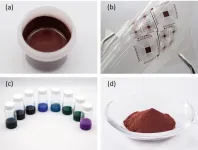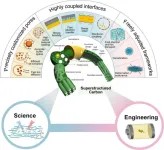(Press-News.org) Dartmouth researchers report they have developed the first smartphone application that uses artificial intelligence paired with facial-image processing software to reliably detect the onset of depression before the user even knows something is wrong.
Called MoodCapture, the app uses a phone's front camera to capture a person's facial expressions and surroundings during regular use, then evaluates the images for clinical cues associated with depression. In a study of 177 people diagnosed with major depressive disorder, the app correctly identified early symptoms of depression with 75% accuracy.
These results suggest the technology could be publicly available within the next five years with further development, said the researchers, who are based in Dartmouth's Department of Computer Science and Geisel School of Medicine. The team published their paper on the arXiv preprint database in advance of presenting it at the Association of Computing Machinery's CHI 2024 conference in May. Papers presented at CHI are peer-reviewed prior to acceptance and will be published in the conference proceedings.
"This is the first time that natural 'in-the-wild' images have been used to predict depression," said Andrew Campbell, the paper's corresponding author and Dartmouth's Albert Bradley 1915 Third Century Professor of Computer Science. "There's been a movement for digital mental-health technology to ultimately come up with a tool that can predict mood in people diagnosed with major depression in a reliable and non-intrusive way."
"People use facial recognition software to unlock their phones hundreds of times a day," said Campbell, whose phone recently showed he had done so more than 800 times in one week.
"MoodCapture uses a similar technology pipeline of facial recognition technology with deep learning and AI hardware, so there is terrific potential to scale up this technology without any additional input or burden on the user," he said. "A person just unlocks their phone and MoodCapture knows their depression dynamics and can suggest they seek help."
For the study, the application captured 125,000 images of participants over the course of 90 days. People in the study consented to having their photos taken via their phone's front camera but did not know when it was happening.
A first group of participants was used to program MoodCapture to recognize depression. They were photographed in random bursts using the phone’s front-facing camera as they answered the question, "I have felt down, depressed, or hopeless." The question is from the eight-point Patient Health Questionnaire or PHQ-8, which is used by clinicians to detect and monitor major depression.
The researchers used image-analysis AI on these photos so that MoodCapture's predictive model could learn to correlate self-reports of feeling depressed with specific facial expressions—such as gaze, eye movement, positioning of the head, and muscle rigidity—and environmental features such as dominant colors, lighting, photo locations, and the number of people in the image.
The concept is that every time a user unlocks their phone, MoodCapture analyzes a sequence of images in real-time. The AI model draws connections between expressions and background details found to be important in predicting the severity of depression, such as eye gaze, changes in facial expression, and a person's surroundings.
Over time, MoodCapture identifies image features specific to the user. For example, if someone consistently appears with a flat expression in a dimly lit room for an extended period, the AI model might infer that person is experiencing the onset of depression.
The researchers tested the predictive model by having a separate group of participants answer the same PHQ-8 question while MoodCapture photographed them and analyzed their photos for indicators of depression based on the data collected from the first group. It is this second group that the MoodCapture AI correctly determined were depressed or not with 75% accuracy.
"This demonstrates a path toward a powerful tool for evaluating a person's mood in a passive way and using the data as a basis for therapeutic intervention," said Campbell, noting that an accuracy of 90% would be the threshold of a viable sensor. "My feeling is that technology such as this could be available to the public within five years. We've shown that this is doable."
MoodCapture meets major depression on the irregular timescale on which it occurs, said Nicholas Jacobson, a study co-author and assistant professor of biomedical data science and psychiatry in Dartmouth's Center for Technology and Behavioral Health.
"Many of our therapeutic interventions for depression are centered around longer stretches of time, but these folks experience ebbs and flows in their condition. Traditional assessments miss most of what depression is," said Jacobson, who directs the AI and Mental Health: Innovation in Technology Guided Healthcare (AIM HIGH) Laboratory.
"Our goal is to capture the changes in symptoms that people with depression experience in their daily lives," Jacobson said. "If we can use this to predict and understand the rapid changes in depression symptoms, we can ultimately head them off and treat them. The more in the moment we can be, the less profound the impact of depression will be."
Jacobson anticipates that technologies such as MoodCapture could help close the significant gap between when people with depression need intervention and the access they have to mental-health resources. On average, less than 1% of a person's life is spent with a clinician such as a psychiatrist, he said. "The goal of these technologies is to provide more real-time support without adding an additional pressure on the care system," Jacobson said.
An AI application like MoodCapture would ideally suggest preventive measures such as going outside or checking in with a friend instead of explicitly informing a person they may be entering a state of depression, Jacobson said.
"Telling someone something bad is going on with them has the potential to make things worse," he said. "We think that MoodCapture opens the door to assessment tools that would help detect depression in the moments before it gets worse. These applications should be paired with interventions that actively try to disrupt depression before it expands and evolves. A little over a decade ago, this type of work would have been unimaginable."
The study stems from a National Institutes of Mental Health grant Jacobson leads that is investigating the use of deep learning and passive data collection to detect depression symptoms in real-time. It also builds off a 2012 study led by Campbell's lab that collected passive and automatic data from the phones of participants at Dartmouth to assess their mental health.
But the advancement of smartphone cameras since then allowed the researchers to clearly capture the kind of "passive" photos that would be taken during normal phone usage, Campbell said. Campbell is director of emerging technologies and data analytics in the Center for Technology and Behavioral Health where he leads the team developing mobile sensors that can track metrics such as emotional state and job performance based on passive data.
The new study shows that passive photos are key to successful mobile-based therapeutic tools, Campbell said. They capture mood more accurately and frequently than user-generated photographs—or selfies—and do not deter users by requiring active engagement. "These neutral photos are very much like seeing someone in-the-moment when they're not putting on a veneer, which enhanced the performance of our facial-expression predictive model," Campbell said.
Subigya Nepal, a Guarini School of Graduate and Advanced Studies PhD candidate in Campbell's research group who, along with PhD student Arvind Pillai, Guarini, is co-lead author of the study, said the next steps for MoodCapture include training the AI on a greater diversity of participants, improving its diagnostic ability, and reinforcing privacy measures.
The researchers envision an iteration of MoodCapture for which photos never leave a person's phone, Nepal said. Pictures would instead be processed on a user's device to extract facial expressions associated with depression and convert them into code for the AI model. "Even if the data ever does leave the device, there would be no way to put it back together into an image that identifies the user," he said.
Meanwhile, the application's accuracy could be enhanced on the consumer end if the AI is designed to expand its knowledge based on the facial expressions of the specific person using it, Nepal said.
"You wouldn't need to start from scratch—we know the general model is 75% accurate, so a specific person's data could be used to fine-tune the model. Devices within the next few years should easily be able to handle this," Nepal said. "We know that facial expressions are indicative of emotional state. Our study is a proof of concept that when it comes to using technology to evaluate mental health, they're one of the most important signals we can get."
###
END
Smartphone app uses AI to detect depression from facial cues
Study: MoodCapture app opens the door to real-time digital mental health support.
2024-02-27
ELSE PRESS RELEASES FROM THIS DATE:
First DNA study of ancient Eastern Arabians reveals malaria adaptation - study
2024-02-27
People living in ancient Eastern Arabia appear to have developed resistance to malaria following the appearance of agriculture in the region around five thousand years ago, a new study reveals.
DNA analysis of the remains of four individuals from Tylos-period Bahrain (300 BCE to 600 CE) - the first ancient genomes from Eastern Arabia - revealed the malaria-protective G6PD Mediterranean mutation in three samples.
The discovery of the G6PD Mediterranean mutation in ancient Bahrainis suggests that many people in ...
Pitt study shows bariatric surgery is more effective than medical and lifestyle interventions for diabetes control and remission
2024-02-27
PITTSBURGH, Feb. 27, 2024 – Bariatric surgery is more effective than medical and lifestyle modifications for achieving long-term Type 2 diabetes control and remission, according to new research led by a University of Pittsburgh School of Medicine surgeon-scientist and published today in JAMA.
In the largest and longest randomized follow-up study to date, the researchers also found that bariatric surgery improved cholesterol and triglyceride levels more effectively than did medical and lifestyle modifications. Since diabetes and cholesterol are important risk factors for heart disease, the management of both may contribute to fewer heart attacks, strokes and other complications.
“This ...
Long-term outcomes of medical management vs bariatric surgery in type 2 diabetes
2024-02-27
About The Study: After 7 to 12 years of follow-up, individuals originally randomized to undergo bariatric surgery compared with medical/lifestyle intervention had superior glycemic control with less diabetes medication use and higher rates of diabetes remission.
Authors: Anita P. Courcoulas, M.D., of the University of Pittsburgh, is the corresponding author.
To access the embargoed study: Visit our For The Media website at this link https://media.jamanetwork.com/
(doi:10.1001/jama.2024.0318)
Editor’s Note: Please see the article for additional information, including other authors, author contributions and affiliations, conflict ...
Changes in health care workers’ economic outcomes following Medicaid expansion
2024-02-27
About The Study: In this study, only health care workers in higher-earning occupations (e.g., registered nurses, physicians, and managers) experienced increases in annual income after state-level Medicaid expansion, which has been shown to improve health care organization finances. These findings suggest that improvements in health care sector finances may increase economic inequality among health care workers, with implications for worker health and well-being.
Authors: Sasmira Matta, M.H.S., of the University of Pennsylvania in Philadelphia, is the corresponding author.
To access the embargoed study: ...
Socioeconomic status, palliative care, and death at home among patients with cancer before and during covid-19
2024-02-27
About The Study: The findings of this study of 173,000 adult patients who died with cancer suggest that the COVID-19 pandemic was associated with amplified socioeconomic disparities in death at home and specialized palliative care delivery at the end of life. Future research should focus on the mechanisms of these disparities and on developing interventions to ensure equitable and consistent specialized palliative care access.
Authors: Camilla Zimmermann, M.D., M.P.H., Ph.D., of the Princess Margaret Cancer Centre in Toronto, is the corresponding ...
Routine fecal occult blood screening and colorectal cancer mortality in Sweden
2024-02-27
About The Study: This study of routine screening with fecal occult blood testing found a 14% decrease in colorectal cancer mortality associated with screening. The true association of screening with reduced mortality is expected to be higher due to some coexistence of testing in the control group and colorectal cancer deaths diagnosed more than two years after screening.
Authors: Johannes Blom, M.D., Ph.D., of the Karolinska Institutet in Stockholm, is the corresponding author.
To access the embargoed study: Visit our For The ...
Au@Cu7S4 Yolk@Shell nanocrystals set new hydrogen production activity record under visible and near infrared irradiation
2024-02-27
The sunlight received by Earth is a mixed bag of wavelengths ranging from ultraviolet to visible to infrared. Each wavelength carries inherent energy that, if effectively harnessed, holds great potential to facilitate solar hydrogen production and diminish reliance on non-renewable energy sources. Nonetheless, existing solar hydrogen production technologies face limitations in absorbing light across this broad spectrum, particularly failing to harness the potential of NIR light energy that reaches Earth.
Recent research has identified that both Au and Cu7S4 nanostructures exhibit a distinctive optical characteristic known as localized surface plasmon resonance (LSPR) (Fig.1). ...
Press program now available for the world's largest physics conference
2024-02-27
The American Physical Society’s March Meeting begins next week with presentations on new research in climate science, medicine, biological physics, quantum information, superconductivity, condensed matter, and more. The conference will be in person in Minneapolis and online everywhere March 3-8.
Press Kit
There are no press conferences planned for this year’s program. However, tip sheets about newsworthy presentations are now available in the March Meeting press kit. Registered journalists and public information officers will also receive emails with press information daily for the duration of the meeting.
Press Room
In-person press registrants ...
Development of a thick-film conductive ink suitable for large-area, large-current printed electronics
2024-02-27
1. NIMS, Sumitomo Metal Mining Co., Ltd. (based in Minato City, Tokyo), N.E. CHEMCAT CORPORATION (based in Minato City, Tokyo) and Priways Co., Ltd. (a NIMS-founded startup based in Tsukuba, Ibaraki) have jointly developed a thick-film, electrically conductive ink suitable for printing electronic circuits and sensors on the surfaces of films and other substrates to manufacture printed electronics. Sumitomo Metal Mining and Priways displayed the ink during the 38th Nepcon Japan exhibition to be held from January ...
Customizable carbon and its potential impact on green energy
2024-02-27
There’s a lot of research about moving away from carbon as an energy source, but what if instead the carbon that is being used is applied to its full capacity?
The importance of carbon as an energy source is not to be downplayed. Unfortunately, the reliance on these carbon-based materials has proven to be disastrous for the environment, especially in the quantities they are consumed on a global basis. Therefore, alternative means have to be researched. Superstructure carbons (SCC) are a possible way to use carbons in a more efficient and “green” way that can exceed the current performance and longevity ...
LAST 30 PRESS RELEASES:
Cannabis legalization is driving increases in marijuana use among U.S. adults with historically lower consumption rates
Multifunctional dipoles enabling enhanced ionic and electronic transport for high‑energy batteries
Triboelectric nanogenerators for future space missions
Advancing energy development with MBene: Chemical mechanism, AI, and applications in energy storage and harvesting
Heteroatom‑coordinated Fe–N4 catalysts for enhanced oxygen reduction in alkaline seawater zinc‑air batteries
Meta-device for precision lateral displacement sensing
Plasma-guided mitotane for the treatment of adrenocortical carcinoma: adjuvant care to advanced disease
Theoretical study of laser-enhanced nuclear fusion reactions
Social environment impacts sleep quality
Optimized kinetic pathways of active hydrogen generation at Cu2O/Cu heterojunction interfaces to enhance nitrate electroreduction to ammonia
New design playbook could unlock next generation high energy lithium ion batteries
Drones reveal how feral horse units keep boundaries
New AI tool removes bottleneck in animal movement analysis
Bubble netting knowledge spread by immigrant humpback whales
Discovery of bats remarkable navigation strategy revealed in new study
Urban tributaries identified as major sources of plastic chemical pollution in the Yangtze River
UK glaucoma cases higher than expected and projected to reach 1.6 million+ by 2060
Type 2 diabetes prevention could more than halve carbon footprint linked to disease complications
Over 1 million estimated to have glaucoma in UK
Early treatment can delay rheumatoid arthritis for years
National childhood type 1 diabetes screening is effective and could prevent thousands of emergency diagnoses, UK study shows
Mix of different types of physical activity may be best for longer life
Continuous care from community-based midwives reduces risk of preterm birth by 45%
Otago experts propose fiber as first new essential nutrient in 50 years
Auburn Physics PhD student earns prestigious DOE Fellowship
AI tool helps you learn how autistic communication works
To show LGBTQ+ support, look beyond Pride Month
Using artificial intelligence to understand how emotions are formed
Exposure to wildfire smoke late in pregnancy may raise autism risk in children
Breaking barriers in lymphatic imaging: Rice’s SynthX Center leads up to $18 million effort for ‘unprecedented resolution and safety’
[Press-News.org] Smartphone app uses AI to detect depression from facial cuesStudy: MoodCapture app opens the door to real-time digital mental health support.



